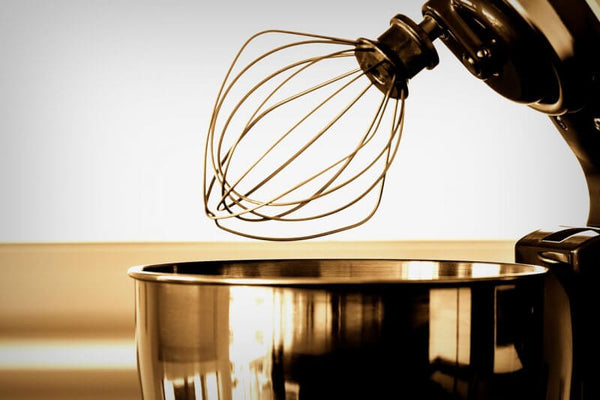Buying Your First Industrial Kitchen Mixer

Industrial kitchen mixers are highly versatile, with a variety of attachments that can handle specialty mixing jobs. They're an essential piece of equipment for any commercial kitchen. Almost every industrial kitchen mixer includes a bowl, a bowl lift wheel, a bowl guard, front/rear covers, mixing attachments, and onboard controls. However, there are a few different styles of mixer to choose from, so it helps to know how you're going to use it before window shopping. In this deep dive, we've shared how to buy your first industrial kitchen mixer, with a breakdown of the various mixer types, drive systems, and attachments. Some mixer configurations are better suited for certain industries and cuisines, and this guide will help you narrow down your search for the perfect mixer.
What can you use an industrial kitchen mixer for?
Whether you're mixing a lot of dough for pizza or running a full-fledged bakery, there are a wide range of applications for a commercial mixer. Here are a few of the primary mixer types and their intended uses:
- Planetary Mixers: It's named for the movement of the mixer, which orbits the bowl like a planet orbiting the Sun. These commercial mixers are excellent for making fresh whipped cream, mashed potatoes, and other dishes that have a lot of moisture. Planetary mixers have at least four agitator attachments, so they offer plenty of functionality for chefs. Sizes range from 20-quart countertop mixers to giant 200-quart floor models. Also known as "cake mixers", bakers love using them to make batters for cakes and pastries.
- Spiral Mixers: Named for the shape of their agitator attachment, spiral mixers tend to have faster motors than planetary mixers. This is great for high-volume mixing with dense dough, which is why they're commonly called "dough mixers". Many large-scale pizzerias and bakeries rely on spiral mixers to get them through a busy service. Some spiral mixers can handle up to 600 pounds of dough, especially if the mixer has a hydraulic bowl lift. These specialty mechanisms help lift heavy bowls so the dough can be prepped.
- Vertical Cutter Mixers: Designed with a covered mixing bowl and a high-powered motor, you can use a vertical cutter for fast mixing without a mess. They're great for mixing vegetables, meat, and dough. Some kitchens use them to blend smooth mousses as well.
We've outlined some different mixer styles, but how do these mixers get power from the motor? There are two main drive systems, which have distinct pros and cons:
- Belt-Driven: These drive systems are more affordable to repair than gear-driven systems. You can adjust speed in real time, and the belt design allows for a variety of speed settings. However, belts can "slip" on the drive, which lowers the velocity ratio and weakens your mixer.=
- Gear-Driven: These drive systems don't "slip", but repairs are typically more expensive than belt systems. Gears last a long time, but they're usually louder than belts.
Here are just a few of the most useful mixer attachments and accessories:
- Mixing Bowls: Every mixer should come with a fitted bowl that matches the mixer's size. In addition, many planetary mixers have the ability to use a small mixing bowl for smaller jobs, which can save you cleaning time.
- Bowl Scraper: This mixer attachment scrapes the inside of the mixing bowl while the agitator is running. This speeds up the mixing process, reduces waste, and limits the amount of time you're manually scraping the bowl.
- Wire Whip: Similar to a large whisk, this oval whip attachment is ideal for mixing light dishes like meringues and whipped cream.
- Pastry Knife: Designed for mixing pie and pizza dough, this sharp attachment cuts through thick batter.
- Flat Beater: With a flat surface that extends across the mixing bowl, a flat beater is great for mixing brownies, cookie dough, and cake batter.
- Dough Hook: This spiral hook looks a little frightening, but the shape is perfect for kneading and folding dough. Whether you're baking bread or making pizza, you need a dough hook in your arsenal.
Before spending thousands of dollars on a commercial mixer, you should ask yourself a few questions:
- What ingredients do you need to mix?: Every ingredient and batter has a unique consistency, and some mixers won't be powerful enough for your needs. A thick pizza dough needs a faster motor (i.e. a spiral mixer) than your average mixer, while a pastry chef might not need all that power. To help decide, take a look at the absorption ratio for your most commonly made dough. This is found by dividing lbs. of water by lbs. of flour. A lower absorption rate means a thicker dough, which will require a more powerful motor.
- How much product do you need to mix?: The size of your foodservice operation will dictate what size mixer you need. For instance, small restaurants can make do with a 10 to 20 qt. planetary mixer, while large-scale bakeries and pizzerias may need a spiral mixer to meet their demand.
- What style of mixing are you primarily doing?: Every commercial is built to handle heavy use, but some mixers are better at certain tasks than others. Before making a purchase, dig deep into the mixer's specs online and find out what the limits are for that particular machine. You might find out that the mixer isn't ideal for your foodservice business, and you'd be better off with a different style.

















